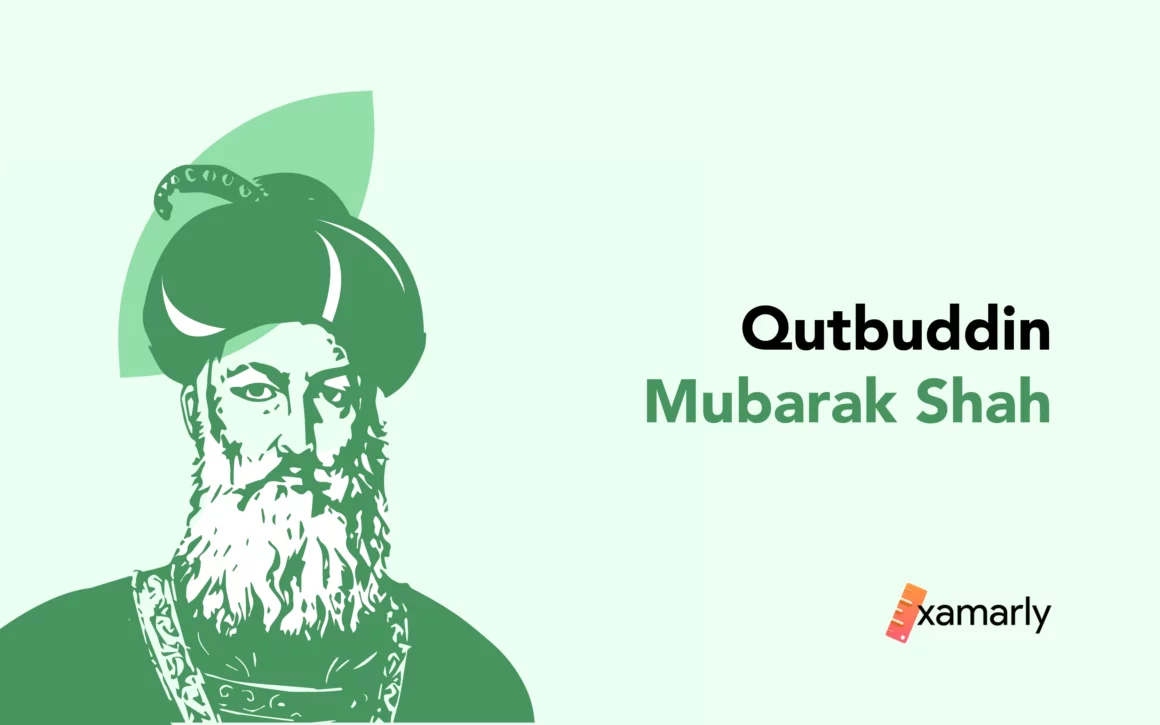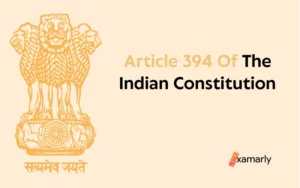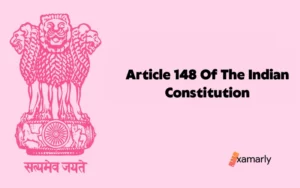Qutb-ud-din Mubarak Shah ruled the Delhi Sultanate. He was the child of Ala-ud-din Khilji. He managed to escape Malik Kafur’s grasp and emerged as the Sultan of the Khilji Dynasty.
Prince Mubarak, who was 18 then, was appointed as an official to his younger, six-year-old brother who was the monarch at the time. Within two months, Qutb-ud-din established the kingdom.
After taking the throne, he adopted populist measures like eliminating his father’s harsh taxes and fines and releasing hundreds of inmates. In 1320, he was killed by one of his reliable people Khusrau Khan.
Read this article to learn more about Qutbuddin Mubarak Shah. For those preparing for the UPSC exam, this information would be extremely helpful. This is a part of the UPSC Syllabus covered under Medieval Indian History.
- Early Life of Qutbuddin Mubarak Shah Khilji
- Ascension
- Administration
- Military Campaigns
- Assassination
- Successor
- Conclusion
- FAQs on Qutbuddin Mubarak Shah
- Who among the Delhi Sultans proclaimed himself to be the Khalifa?
- How Khilji Dynasty came to an end?
- Who was the successor of Qutbuddin Mubarak Shah?
- Who was the last ruler of the Khilji empire?
- When did Qutbuddin Mubarak Shah sit on the throne?
- Who was the founder of the Khilji Dynasty?
- Who killed Qutb-Ud-Din Mubarak Khilji?
Early Life of Qutbuddin Mubarak Shah Khilji
Mubarak Khan is another name for Qutubuddin Mubarak Shah. He was the child of Jhatyapali and Alauddin Khalji. Ramachandra of Devagiri was the father of Jhatyapali.
After Alauddin passed away on January 4, 1316, his slave-general Malik Kafur crowned Shihabuddin Omar, Alauddin’s 6-year-old son, as a puppet king. Kafur himself became the regent.
Mali Kafur caused blindness to Khizr Khan, who was the designated ruler, along with his brother Shadi Khan, while they were imprisoned in the Gwalior fort.
The family members of Alauddin were later targeted by Kafur because he saw them as a challenge to his authority over the kingdom. Mubarak Shah posed a severe threat and was thus imprisoned.
After killing Malik Kafur, Mubarak Shah was set free by the ex-bodyguards (paiks) of Alauddin.
According to a story reported by the chronicler Firishta from the 16th century, Kafur delivered some paiks to Mubarak Shah the blind. Instead, they were persuaded to assassinate Kafur by the captured prince, who gave them his jeweled necklace. This story is modern fiction, though.
The paiks were the ones who decided to assassinate Kafur on their own, claims the older chronicler Ziauddin Barani.
According to a story related by the chronicler Firishta, who lived in the 16th century, Kafur dispatched some paiks to Mubarak Shah to blind him, but the imprisoned prince gave them his glittering necklace and persuaded them to assassinate Kafur instead.
This story, however, was made up afterward because the paiks were the ones who decided to assassinate Kafur, according to the previous chronicler Ziauddin Barani.
Ascension
At the age of 17 or 18, Mubarak Shah assumed the title Qutubuddin and inherited the throne on April 14, 1316. He maintained Alauddin’s officers and governors. This guaranteed a stable government during his first year in power.
He made several policies during his rule, some of which are stated as follows-
- Under Alauddin, Malik Dinar, who served as the shuhna-i pil received the title of Zafar Khan.
- Muhammad Maulana was awarded the title, Sher Khan.
- He was given the Jagirdari system. Jagirs were also given to Amirs, aristocrats, saints, and scholars.
- Price control was abolished and the taxation strategy was changed.
- He substituted the philosophy of “forgive and forget” for Allauddin Khalji’s “blood and iron” ideology.
- The title Qazi Khan and the position of sadr-i Jahan were bestowed upon Maulana Ziauddin. Additionally, a gold dagger that was set with gems was given to him.
- About 14 jobs were given to Malik Qara Beg. He also gave significant positions to his sons.
- Son of Tughluq (Ghazi Malik), Malik Fakhruddin Juna, was appointed Amir Akhur.
- Mubarak Shah upheld Alauddin’s ban on alcohol. But the enforcement was lax and alcohol was carried into the capital.
The assassins of Malik Kafur desired important posts in Mubarak Shah’s court. Also claimed credit for installing him on the throne. Instead, Mubarak Khan ordered their execution.
Administration
Sultan Qutbuddin Mubarak Shah overturned several of Alauddin’s decisions to gain support from the populace. On the day Qutb-ud-din Mubarak Shah ascended to the throne, over 18,000 prisoners were freed and those who had been expelled from the city were given permission to return.
Mubarak Shah banned the revenue ministry from collecting taxes through harsh tactics like whipping and jail.
Mubarak Shah’s orders raised the wages of his soldiers. Besides raising the allowances and stipends for the commanders, he also gave the army personnel a bonus equal to six months’ worth of pay.
Several private holdings in the crown territory had been incorporated under Alauddin’s authority (Khalisa). Mubarak Shah returned the private proprietors of these lands.
Qutbuddin Mubarak Shah was a pleasure-seeker. The nobles and people followed him in doing the same, which led to widespread corruption and the breakdown of the state.
Everyone began to plan an attack on the king by taking advantage of the shortcomings of the new monarch. Harpal-deva proclaimed Devagiri’s independence. Also anointed himself, king, as soon as a revolt against Qutb-ud-din started in Gujarat.
Military Campaigns
Suppression of Rebellion in Gujarat
Alp Khan, the governor, was assassinated during the Gujarati Rebellion. This sparked an uprising among the Gujarati people. Qutb-ud-din sent an army to Gujarat in the first year of his rule to quell the uprising.
The commander of this army was Ain-ul-Mulk Multani. The rebels were routed by Ain-ul-Mulk, who also took back control of Gujarat and Nahrwala. Malik Dinar Zafar Khan was afterward named governor of Gujarat.
The new governor led the province by settling with the Hindu chiefs.
Devagiri/Daulatabad Expedition
Mubarak Shah khalji led a sizable force to Devagiri in April 1317. He gave his father-in-law, Malik Shahin the title of Vafa Malik before departing from Delhi and gave him control of the administration. After the death of Al-ul-din, Devagiri have been recovered by Harpaldeva.
Raghava’s army was beaten by Delhi soldiers. Rana Harpal was kidnapped, executed, and his body was hung at the Devagiri gates.
The governor of Devagiri was chosen to be Malik Yaklakhi. He had previously been Naib-i-Barid-i-Mumalik for Alauddin.
Later, Qutb-ud-din constructed the Jami Masjid there, which Indian Hindus later converted into the Bharat Mata Temple.
Relatable articles:
Siege of Warangal
The Kakatiya kingdom was another kingdom that paid tribute to Alauddin khilji. Prataparudra, the Kakatiya monarch, had ceased paying tribute to Delhi, though. So Mubarak Shah dispatched an army to conquer him.
Khusrau Khan, Khwaja Haji, and Malik Qutlugh headed the army (amir-i shikar). After putting up some fight, Prataparudra decided to seek a ceasefire with the Delhi army as it besieged the Kakatiya capital Warangal.
Khusro Khan advanced to Ellora after conquering the Kakatiyas. He encountered the remaining soldiers when he was returning to Delhi.
Assassination
A plot to assassinate Mubarak Shah and install a Khizr Khan heir to the throne was conceived. Asad-ud-Din, Mubarak Shah’s cousin, betrayed him. When Mubarak Shah learned about the involvement, he executed him.
There is no doubt that Khizr Khan, Shadi Khan, and Shihab-ud-Din all perished.
Deval Devi, the dame of Khizr Khan, was wed by Mubarak Shah.
Mubarak Shah got carried away by his success in the Deccan. The association of comedians and women was something he personally invested all of his energy in.
King Mubarak Shah, who was powerless and undeserving of his title, had a fondness for Khusrau Khan.
Khusrau Khan created a plan to assassinate the sultan. On the night of April 4, 1320, a large number of Baradu, entered the royal palace. They killed the royal guards at the residence.
The Sultan heard the ruckus and wanted to know what was the reason. Khusrau Khan, on the other hand, informed him that the royal horses had escaped, and the disturbance was the result of the palace guards attempting to capture them.
The Sultan attempted to flee to his harem, after realizing that a rebellion was taking place against him. Khusrau Khan, on the other hand, stopped him by grabbing his hair.
Sultan Qutbuddin Mubarak Shah was thrown to the ground and swung an axe at his chest before lifting him by the hair. The Sultan was then cut down to size, and the head was afterward thrown outside, onto the ground floor courtyard. Mubarak Shah’s four disgraceful years came to an end.
Successor
When Mubarak Shah died, Khusro Khan proclaimed himself Nasir-ud-din Khusru Khan.
He abused his authority in the most inexcusable way possible.
In 1320, Ghiyas-ud-din Tughluq overthrew Khusro’s rule.
Conclusion
Jalaluddin Khilji started the Khilji dynasty. He was a calm leader who disapproved of violence. Allauddin Khilji murdered him. Allauddin Khilji was installed as the country’s second monarch.
Following his death, Malik Kafur imprisoned Qutbuddin Mubarak Shah. Muhammad Shah was bisexual. Khusro Khan was his homosexual partner. He adopted Khusrao Shah as his Vazir, but Khusro Khan murdered him in a plot involving the current administration.
In the interest of further readings:
| Delhi Sultanate Dynasty | Delhi Sultanate Questions And Answers For UPSC |
| Delhi Sultanate Administration | Tughlaq Dynasty |
FAQs on Qutbuddin Mubarak Shah
Who among the Delhi Sultans proclaimed himself to be the Khalifa?
The designation Khalifatullah (or Khalifa/Caliph), which appears on his coinage, was adopted by Qutbuddin Mubarak Shah.
How Khilji Dynasty came to an end?
Khusru Khan assassinated Qutbuddin Mubarak Shah in 1320 AD. He could, however, only hold power for a very brief time. Ghiyasuddin Tughlaq also referred to as Ghazi Malik, seized him and executed him in 1320 AD. Thereby Ghazi Malik ended the Khilji Dynasty and laid the foundation of the Tughlaq dynasty.
Who was the successor of Qutbuddin Mubarak Shah?
Khusrau Khan was the Sultan of the Khilji Dynasty who succeeded Qutb-ud-Din Mubarak Shah
Who was the last ruler of the Khilji empire?
Khusrau Khan was the last ruler of the Khilji empire to rule the Sultanate of Delhi. For about two months in 1320, he ruled as Sultan of Delhi. He was overthrown by a band of upstarts led by the illustrious Malik Tughluq, who went on to become his successor. Hence, the Khilji dynasty came to an end.
When did Qutbuddin Mubarak Shah sit on the throne?
Mubarak Shah assumed the title Qutubuddin on April 14, 1316, when he seized the crown. He was perhaps 17 or 18 years of age at that time.
Who was the founder of the Khilji Dynasty?
Jalal ad-din Khalji, who reigned from 1290-1296, founded the Khilji dynasty that followed the Slave dynasty.
Who killed Qutb-Ud-Din Mubarak Khilji?
Khusrau Khan assassinated Qutb-ud-Din Mubarak Khilji and took the power to rule the Sultanate of Delhi and became the next Sultan.






